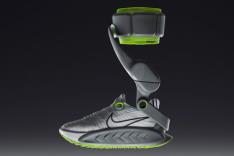4. Use Strength Training to Balance Your Body
You need something -- and what better than muscle? -- to keep your body properly aligned while you're running down the road at 450 pounds of crunching, twisting-in and torquing-out force per stride. According to Ferber, it's particularly important to strengthen the hip muscles. He claims his clinic has cured 92 percent of knee injuries with a hip regimen. "Strengthening the hips is optimal for effective rehabilitation, as opposed to treating the area where the pain is located (e.g., your knee)," he says. "When you strengthen the hips--the abductors, adductors, and gluteus maximus--you increase your leg stability all the way down to the ankle."
Action Plan
You don't want to train for bulging muscles. You need just enough core, hip and lower-leg strength training to keep your pelvis and lower-extremity joints properly positioned. "Healthy running should be as symmetrical and fluid as possible," says Michael Fredericson, M.D., associate professor of sports medicine at Stanford University School of Medicine. "If you don't have muscle balance, then you lose the symmetry, and that's when you start having problems."
Related: Strength Training Program for Runners
5. RICE Works
When you've got muscle aches or joint pains, there's nothing better than rest, ice, compression and elevation for immediate treatment. These measures can relieve pain, reduce swelling, and protect damaged tissues, all of which speed healing. The only problem with RICE is that too many runners focus on the "I" while ignoring the "RCE." Ice reduces inflammation, but to ice-and-run, ice-and-run, without giving the tissues enough time to heal, is a little like dieting every day until 6 p.m. and then pigging out. And so Bruce Wilk, an orthopedic rehabilitation specialist in Miami, has added another letter to the acronym, spelling out PRICE. The P stands for "protection," which means don't run until the injury is better.
ACTION PLAN
RICE is most effective when done immediately following an injury. If you twist your ankle or strain your hamstring, plan to take a few days off from running (see Law II). Apply ice -- for 10 to 15 minutes at a time, several times a day. A homemade ice pack--a baggie filled with ice cubes and water--is best. A bag of frozen vegetables is also effective. If you can, elevate the area (easy for foot and ankle injuries, not so much for hip or hamstring issues) to limit swelling. Compression can also further reduce inflammation and can provide pain relief, especially when you first return to running. An ACE bandage is the simplest way to wrap a swollen area, but Amol Saxena, a sports podiatrist in Palo Alto, California, uses a compression dressing with 3M Coban, a self-adherent over-the-counter product. He then uses kinesio tape or a Darco Body Armor Walker for when the swelling goes down. "The tape pulls up the skin slightly, allowing more blood to flow to the injured area," he says.
Related: The Do's and Don't's of Icing Injuries
6. Run on a Level Surface
Here's another factor that could have a significant impact on running injuries, but has been rarely studied: road camber. No doubt you always run on the left side of the road facing traffic. That's good for safety reasons. But it also gives you a functional leg-length discrepancy, since your left foot hits the road lower on the slope than your right foot. You're also placing your left foot on a slant that tends to limit healthy pronation, and your right foot in a position that encourages overpronation. And you're doing this -- running in an unbalanced way -- 160 to 180 strides a minute for mile after mile, day after day, week after week. Clint Verran, a physical therapist in Lake Orion, Michigan, sees the results of this cambered running in his clinic, where he treats a higher incidence of left-hip injuries in runners than right-hip injuries.
- 3
- of
- 5
Get ACTIVE on the Go


Couch to 5K®
The best way to get new runners off the couch and across the finish line of their first 5K.
Available for iOS | Android







Discuss This Article